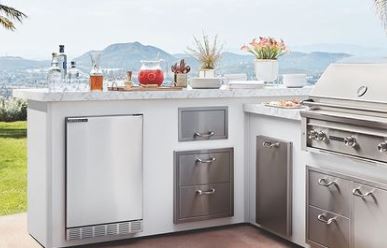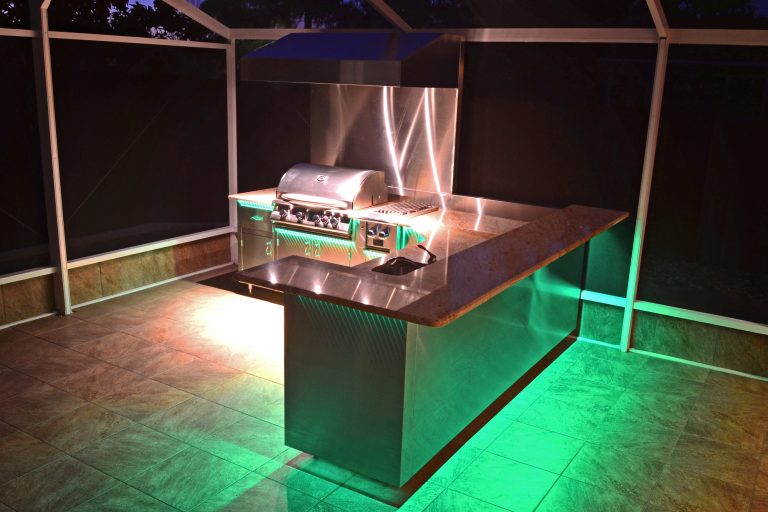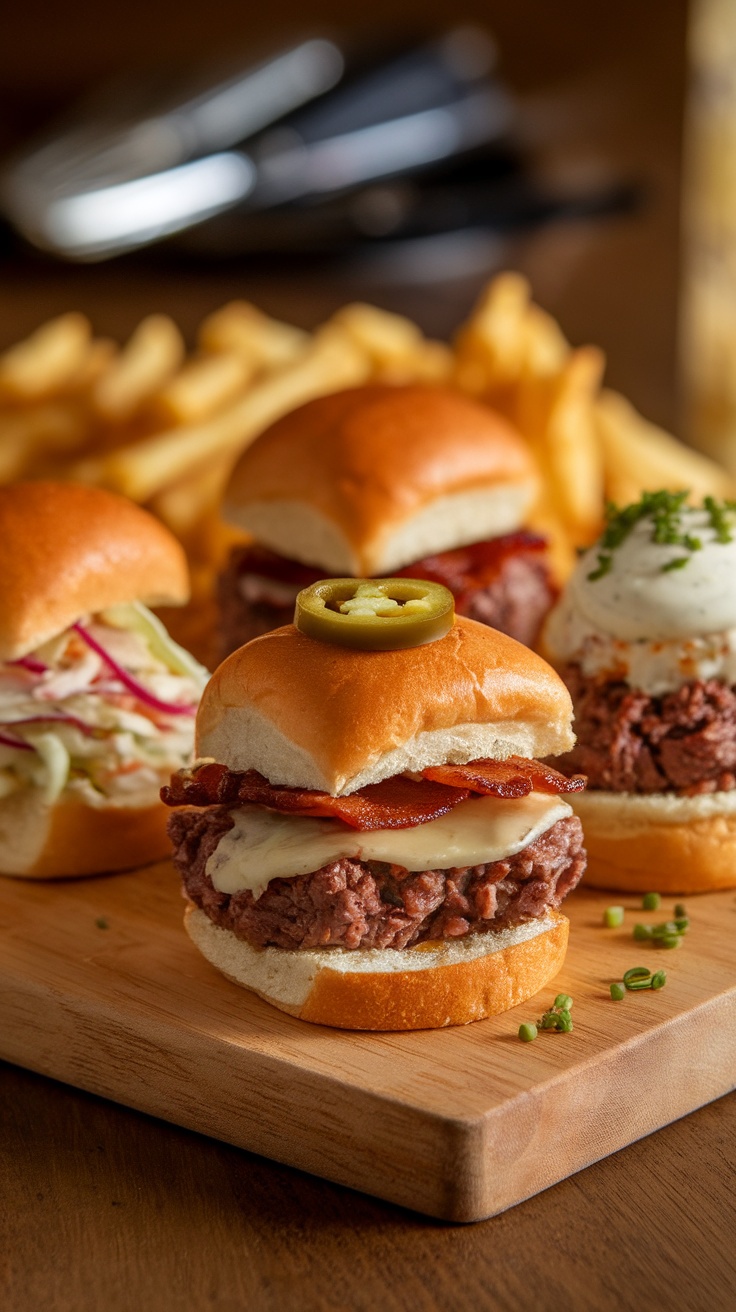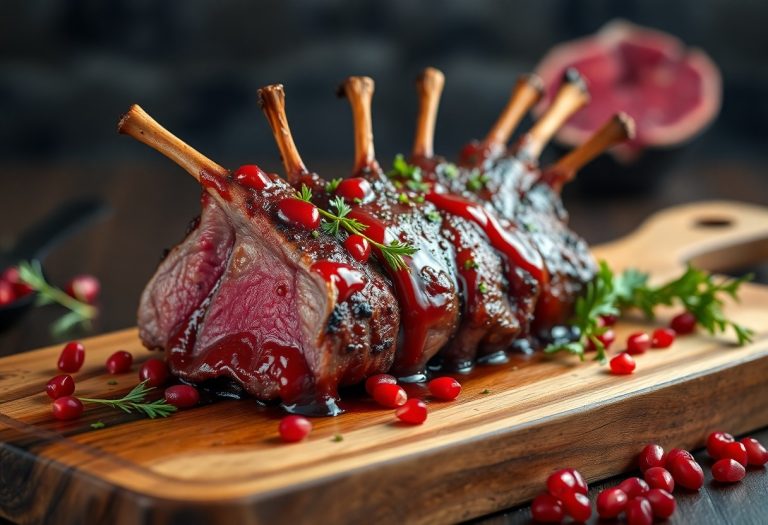How Do Outdoor Refrigerators Work?
Outdoor refrigerators are powered by two different methods. Cold plate refrigeration and forced air refrigeration.
Forced Air Refrigeration
Forced air refrigeration lowers the temperature of the product more quickly and keeps it there. A fan pushes cold air into the cabinet in a forced air system. Although it delivers more uniform temperature dispersion, the unit’s fullness and the presence of glass or metal shelving can impair temperature uniformity throughout the unit.
Glass shelves reduce air flow. Similarly, fridges with metal shelving that are more than three-quarters full restricts the movement of air throughout the interior of the unit.
A refrigerator with a forced air system is constructed similarly to an indoor full-size refrigerator. However, it exceptional insulation in the walls up to 2 inches thick, a powerful circulation fan, a compressor, and an electrical system that is safe for use in the outdoors. You could leave the same food items in it in August or January because the temperature consistency is excellent. The only true disadvantage is that this device is significantly more expensive because it has so many more components.
Cold Plate Refrigeration
Cold plate refrigeration is a static method used in some outdoor fridges. Drinks will be cooler than it is outside regardless of the month, and they may even ice up in January and February. Because a static system does not have a fan, it cools slowly (takes at least a day or two to reach the desired temperature). Most models will only go down to 38-40 degrees Fahrenheit and will have long run times outside. They rely on heat rising to the cold plate to be eliminated, resulting in warmer items at the top of the cabinet, and the plate will typically ice up.
While these units are less expensive, they will not provide speedy cooling, maintain consistent temperatures, or survive long outside. The insulation is enough, but without circulation fans, extra insulation, and a compressor, the temperature will never be truly stable. Because it’s effectively an electric cooler, it’s fine for drinks. For this reason, this refrigeration method is more suitable to beverage fridges.
What Enables an Outdoor Refrigerator to Work So Well?
An outdoor refrigerator can withstand a wider range of temperatures than an inside refrigerator. They are frequently constructed of weather-resistant materials. As a result, outdoor refrigerators are known to be more expensive than entry-level indoor refrigerators.
Outdoor refrigerators feature better insulation, stronger compressors, are built with weather-resistant materials, and have electrical safeguards in place to protect against electric hazards because they are frequently in touch with water.
What are the main considerations with an indoor vs. outdoor refrigerator?
Is it suitable for outdoor use?
When buying a fridge for your outdoor kitchen, patio bar or entertaining space, the most crucial thing to look for is ETL, UL, or CSA outdoor rated certification. Only products that pass a variety of outdoor tests, such as outdoor performance, leak testing, or safety trials, are awarded these certifications.
Examine an outdoor refrigerator’s product description. To show that the fridge outside is safe you should see a stamp of certification which indicates that the unit is outdoor safe.
What kind of material is it composed of?
Stainless steel is used in almost all refrigerators, both indoor fridges and outdoor. It is also used an outdoor appliance such as a bbq grill or ice maker.
The stainless-steel grade differs between indoor fridges and outdoor refrigerators. The greater the grade, the better the rust and corrosion resistance. In order to prevent corrosion in damp weather conditions or surroundings, an outdoor fridge should be made of 304 food-grade stainless steel or higher. Rain, snow, heat, and debris will be more sensitive to anything below a 304grade stainless steel.
Other weatherproofing elements that indoor refrigerators lack are common in outdoor refrigerators. If a refrigerator has door and bearing seals, you can be sure it will last longer and be able to endure harsher circumstances. When these weatherproofing characteristics are combined with the appropriate high-grade material, you have a dependable outdoor refrigerator.
Dependability comes at a price and makes outdoor refrigerators so expensive.
When Do Outdoor Refrigerators Work Best?
Cold Weather Considerations
Winter weather has the potential to damage a refrigerators outside compressor unless it is maintained in a temperature-controlled environment.
A refrigerator that is outside rated and so weather-resistant is better able to resist and operate in winter circumstances; nonetheless, the compressor is still tested when temperatures drop to and remain at extreme levels.
Even if you live in a rainy or snowy climate, you can keep your outdoor refrigerator or outdoor beverage cooler safely stored in your backyard patio or outdoor kitchen. Just make sure it’s empty and unplugged when you’re not going to use it for weeks or months at a time. Your refrigerator will last longer when you do this.
When the temperature dips below 50 degrees Fahrenheit, however, you’ll start to have serious troubles with beverage fridges and using refrigerators outside.
Cooler temperatures (between 32 and 60 degrees Fahrenheit) are ideal for cooling beverages in the refrigerator. Because the fridge doesn’t have to work as hard to keep the contents cool and drinks cold, the overall electrical load is reduced.
While this may appear to be a good thing, it comes with a price. The mechanism that keeps the freezer cold doesn’t work nearly as well because the air traveling through the compressor never heats up adequately again.
Because of the decrease in efficiency, the unit will struggle to keep goods cold.
Cold weather reverses this inefficiency, but freezing conditions (below 32 degrees Fahrenheit) put the compressor at risk of seizing.
While the cold outside will keep your food and drinks cool for the time being, you should double-check that your fridge running when the weather warms up again.
Hot Weather Considerations
Outdoor refrigerators are designed to keep food cold in hot weather. Temperatures above 110 degrees F, on the other hand, may be difficult for them. Up to that point, most manufacturers will guarantee proper cooling.
Keeping the contents of a refrigerator cold after they’ve been chilled is actually fairly simple. Most hot weather only results in somewhat higher electricity expenses, assuming you’re not keeping the refrigerator door open or fetching a new drink every 5 minutes.
However, when the temperature rises above 110 degrees, difficulties can develop. The refrigerator needs to work harder and the hardware is put under more stress.
The components and gaskets/seals will be hotter as a result of the higher temperatures. This can impair their effectiveness and speed up the rate at which they wear out.
What is the best location for an outdoor refrigerator?
Even if your outdoor refrigerator has been subjected to inclement weather, you can still take precautions to ensure that it runs well. Here are a few pointers for maintaining your outdoor refrigerator to get you started whether your fridge is builtin or freestanding.
Increase the Amount of Insulation
Adding additional insulation to the refrigerator will lessen the amount of effort required to keep the mechanicals in good working order.
Consider constructing a full insulated (but yet ventilated) section for your outdoor refrigerator if possible.
Keep the Refrigerator Out of Direct Sunlight
If you have a screened-in patio or a covered porch, simply place the refrigerator or beverage fridges underneath it. If you don’t have one, consider moving it to a more shady part of your patio or outdoor space.
The Fridge Should Be Protected From The Weather
It’s critical that your refrigerator isn’t exposed to rain or snow directly. Hail will also damage the housing so covering freestanding fridges is a good idea.
This might cause your outdoor refrigerator to corrode, resulting in inside damage. Install a tiny platform to keep the fridge off the wet ground if your patio has a problem with standing water.







